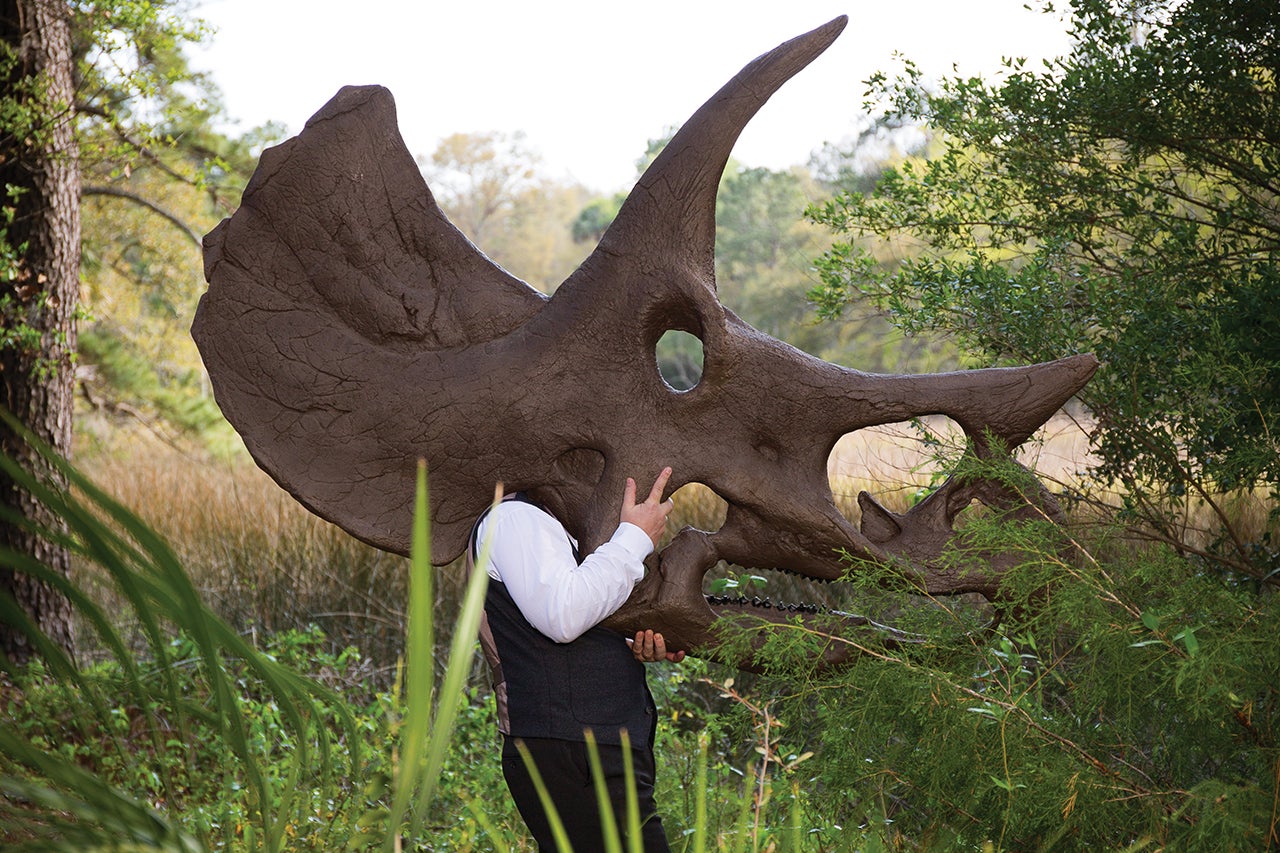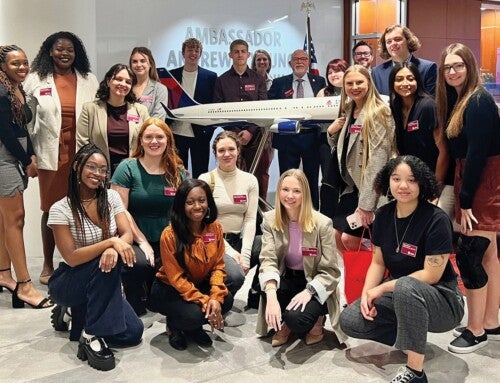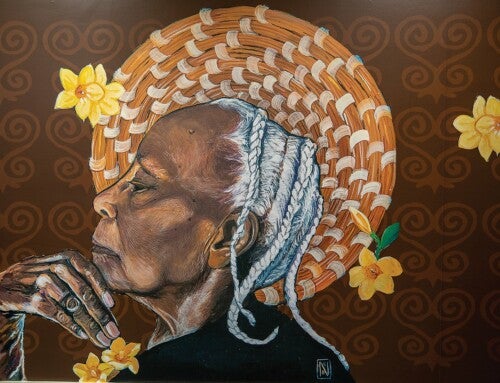Dinosaurs are the stuff of prehistoric legend, beasts from a long bygone era. But for one professor of geology, the study of the Jurassic giants is the jumping point from which to celebrate the beauty of the natural world.
An odd-shaped hump pokes out just above the horizon. If you didn’t know what you were looking at, you would think it’s just part of the rocky, rugged terrain of this part of northwest Wyoming. It’s not.
Braving bitterly frigid December temperatures, a trio of geologists trudge across the treeless, icy landscape of the Morrison Formation with tools and tarps in hand, determined to inspect the uneven mass of land. As they make their way across this lonely, bleak landscape, a biting wind washes across their faces. It’s cold. Really cold.
Despite his physical misery, Phil Manning is like a “kid in a sweet shop.” Sure, these are long days of digging, measuring, studying and planning. It’s all worth it, though, because of the promise of what lies within the dirt.
“This is one of the most pristine, beautiful, desolate, remote, wonderful places on the planet,” says Manning.
The geology professor, his wife and colleague, Victoria Egerton, and College of Charleston alumna Lauren Humphreys ’13 are there to assess this square-mile site, which holds the secrets of the past, present and future. The treasures they’re there to protect are dinosaur bones, which in Manning’s mind can unlock the mysteries of the world for children and college students alike.
“This new dig site is going to have a stack of stegosaurus material,” Manning says, his British accent inflecting with excitement. “There’s already a big stegosaur pelvis slap bang next to one of the sauropod dinosaurs.”
In these early days of winter in the American West, the doggedly persistent professor is dreaming of the endless possibilities these ancient reptile fossils can offer his students. But before the gigantic bones can be unearthed the following summer, Manning has to cover them up one more time. Even old bones need protection from the wrath of Mother Nature.
“This is one of the most pristine, beautiful, desolate, remote, wonderful places on the planet,” says Manning.
The geology professor, his wife and colleague, Victoria Egerton, and College of Charleston alumna Lauren Humphreys ’13 are there to assess this square-mile site, which holds the secrets of the past, present and future. The treasures they’re there to protect are dinosaur bones, which in Manning’s mind can unlock the mysteries of the world for children and college students alike.
“This new dig site is going to have a stack of stegosaurus material,” Manning says, his British accent inflecting with excitement. “There’s already a big stegosaur pelvis slap bang next to one of the sauropod dinosaurs.”
In these early days of winter in the American West, the doggedly persistent professor is dreaming of the endless possibilities these ancient reptile fossils can offer his students. But before the gigantic bones can be unearthed the following summer, Manning has to cover them up one more time. Even old bones need protection from the wrath of Mother Nature.
A little boy runs along the banks of a stream bed at the bottom of his mother’s garden. Hunting for frogs and newts to examine and release, the child’s eyes suddenly dart to a rock jutting out of the ground outside his home in the rural English countryside.
Bright-eyed and curious, the boy abandons his pursuit of the amphibians and makes a beeline for the rock. Crouching down, he meticulously examines a stony shell, turning it over and over in his hands. A slight glint in the earthen formation catches his eye as he brings the baseball-sized hunk close to his ruddy face. The shiny shape within the mineral enraptures the boy, sending his imagination into overdrive.
Years later, Phil Manning would learn that what he had discovered tucked in the dirt outside his Somerset home was a fossilized gastropod (a giant marine snail) forever preserved in mudstone and sparry calcite.
“It’s pretty,” he says, adding “it stays with me.”
As a child, he didn’t dream of traveling the globe and unearthing behemoth beasts from the Triassic, Jurassic and Cretaceous Periods. He didn’t envision leading groundbreaking research using synchrotron light to reveal new details of the biochemistry of long extinct animals. And, he hadn’t yet developed a taste for storytelling that would land him on the likes of the BBC and the National Geographic Channel. He just wanted to play outside.
“I don’t know what I really wanted to do as a kid,” he says, his voice lilting slightly. “I think I was just inquisitive. I loved being outside. I loved the environment. I used to love just traipsing up river beds, looking for stuff and hunting for fossils. I just loved getting out there and exploring the world.”
That pretty much sums up Phil Manning: a student of the world who is always on a quest to see something new, unearth a new detail of life’s long history and celebrate those wonders with whoever will listen.
Students slowly trickle into a classroom in the School of Sciences and Mathematics Building on a cool November morning.
Buzzing about a paper due that day, one student proclaims, “Is today the day?”
Not dwelling on the much-anticipated assignment, students chat with geology professor Phil Manning about their weekend adventures and their growing stress as the semester inches to a close. One student jokingly inquires why Manning is “so scruffy today,” noting the professor’s unshaven face.
“The reason I’m scruffy today is to feel at one with all of you who are also scruffy today,” Manning quips before clarifying that he’s preparing to do fieldwork in the frigid Bighorn Basin of Wyoming. “The air temperature at the moment is in the low twenties. So, to put it in British, that’s minus 10 to minus 15 Celsius I’ll be working in. So, I’m going to grow any facial hair I can since I’ve got no hope of growing any on top of my head.”
Then, it’s down to business as Manning delves into the day’s lecture, working through the dinosauria(that’s the scientific term for dinosaurs) based on their key physical characteristics. The centerpiece of the day’s discussion explores the armored dinosaurs, including “two major groups we all know and love,” says Manning, “stegosaurs and ankylosaurs.”
Manning describes ankylosaurs as “dumpy-sized beasties with their origins in the late Jurassic Period.” But the Stegosaurus needs no introduction, with the profile of the creature’s iconic armored plates extending up along its spine well known to anyone who’s seen such dino movie classics as Jurassic Parkor The Land Before Time.
“They’re a curious group – the stegs,” Manning notes, before launching into a geography lesson on where various types of stegosaurs have been found throughout the world, what period they come from and the importance of assessing the evolution of dinosaurs with a paleobiogeographic approach. “It’s all about why these animals are where they are when they are in time.”
That’s the thing about Manning’s GEOL 333 class. Although his specialty is dinosaurs, this class, which focuses on paleobiology, is an investigation of the record of all past life on Earth. Its aim is to help students connect the evidence of previous life in the fossil record with patterns of evolution. Heady stuff.
An intersection of multiple disciplines, geoscience and paleobiology is an amalgamation of chemistry, physics, biology, art, engineering, computer science and mathematics – to name but a few of the fields that intersect within the earth sciences.
Manning’s expertise in paleontology, the study of the fossil remains of plants and animals (particularly dinosaurs), seamlessly dovetails with what geology and environmental geosciences department chair Tim Callahan sees as the goals of the program, mainly to educate students and the public on the importance of earth science and how the planet’s systems affect us every day.
“From the amazing landscapes around the world that continue to change and affect human civilization, to our place in the spectrum of evolution of life and how things have come to be, we stand humbly in wonder of the universe and strive to understand our place in it,” says Callahan. “We nurture that mindset in our students, who then carry forward their knowledge and excitement for science.”
And, in Manning’s class, the students are up to the challenge. They love learning how fossils can reveal clues about the world of long-extinct creatures. And more to the point, what that says about our environment today.
“You can tell, for instance, from the chemistry of some specimens if the atmosphere was oxygenated or what the temperature was like,” says Michel Cuvillier, a senior majoring in geology.
Senior Laura Schramm, who is also a geology major, says the course paints a great picture of uniformitarianism, the theory that changes in the Earth’s crust over geological history have resulted in continuous and uniform processes.
“The present is the key to the past,” Schramm says, “especially right now when there is so much misunderstanding about climate change. The ability to understand and have evidence for how our earth has changed over time is, I think, of key importance.”
Manning thinks so, too.
A rich voice, thick with the flourishes of a Shakespearean actor, floats across the living room of a home in rural Somerset, England. Describing, in exciting detail, the behavior of this episode’s creatures, a young David Attenborough enthralls audiences with up-close encounters of monkeys in South American rain forests, jelly fish in southern Australia and single-cell organisms in a backyard pond.
Attenborough proclaims: “There are some four million different kinds of animals and plants in the world; four million different solutions to the problems of staying alive. This is the story of how a few of them came to be as they are.”
That is the opening monologue to Attenborough’s ground-breaking 1979 television series Life on Earth.
Growing up in a tiny village of just a few hundred people, Manning had a limited view of the world. Documentarians, like the famed Sir David Attenborough, gave the dewy-eyed child a window to a world much bigger than the one he knew.
“He was my hero,” says Manning. “I remember as a kid watching documentaries and them giving me this broad love of the natural world.”
So, when the opportunity for Manning to be on camera in an educational documentary about geology knocked, he answered. At the time an assistant curator at the Museum of Isle of Wight Geology on Isle of Wight (after a year of working in the print industry just out of college), he jumped at the chance to unleash his inner Attenborough when a crew from London showed up wanting to add some “texture” for their program on the natural world.
“Having been inspired by Attenborough, I took my first tentative steps into the world of television,” says Manning, who, along with his older brother, was one of the first in his family to graduate from college. “I thought it would be great fun. I got the go-ahead from the boss and so I filmed this thing with kids from London who had never been to the seaside before, talking about geology, talking about the history of the earth, talking about how coastal processes had changed the shape of the Isle of Wight through time.”
And, something clicked. Media crews kept contacting the budding natural historian and geologist to do spots on their shows and documentaries as he pursued his career in academia, first earning his master’s in paleontology from the University of Manchester in 1993 and then his doctorate in paleontology from the University of Sheffield in 1999. In 2002, he shot an episode of Horizon, the U.K.’s equivalent of Nova, and his demand in the natural history entertainment sphere exploded. He started doing educational science shorts for the BBC, and later the series Fossil Detective. In 2011, he signed on to do the series Jurassic CSI for the National Geographic Channel.
Then in 2013 Manning contributed to Dinosaur 13, the Emmy award–winning documentary about the battle between scientists at the Black Hills Institute, the United States government and Native American tribes (among a host of others) over ownership rights of the largest, most complete T. rex skeleton ever found.
“I’ll never forget the first time I met him,” recalls Dinosaur 13 director Todd Miller. Miller was doing research at the Black Hills Institute when a dusty car rolled up, a bunch of pelican cases precariously stacked on the vehicle’s roof. As if in a Muppets movie, a flood of dirty grad students began pouring out of the sedan. Eventually Manning made his way out of the packed car, too. “I just remember him barking orders at all the grad students, trying to get the specimens under lock and key. It was weird to see a British guy just barking orders at everybody in the middle of South Dakota.”
Struck by Manning’s ability to effectively and succinctly communicate the universe of paleontology, Miller later asked the then University of Manchester professor of natural history to share his knowledge of the Hell Creek Formation where “Sue,” the T. rex, was found for the documentary.
The pair are now in the process of developing a science-based series with a major American television network that would feature Manning as the host of the show.
“Our goal is to try to make educational and entertaining pieces of media (about the natural world) and there’s nobody better than Phil at doing that,” says Miller, whose independent film production company, Statement Pictures, would produce the new science series. “I’ve never seen him say the same thing twice. He’s always thinking of a different way of communicating what he does to as many different, diverse groups of people as possible. And I think that’s what separates him from the rest.”
Manning says his hope for every science documentary he does is simple: “If we can recreate something that inspired a kid in Somerset to sit down for an hour and be utterly gobsmacked about how wonderful this world is, both past and present, then it’s effort well spent.”




